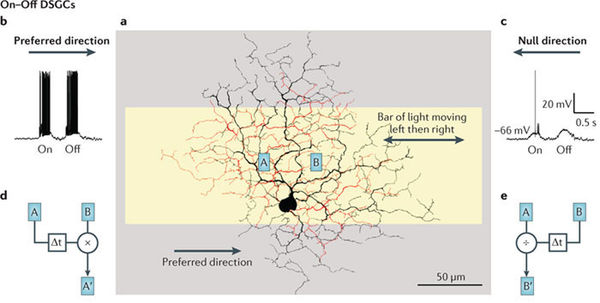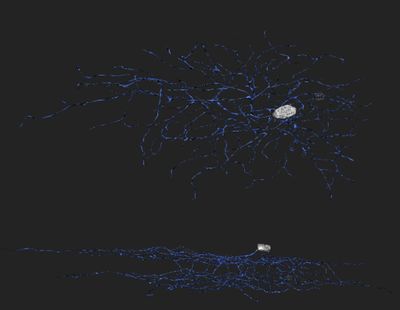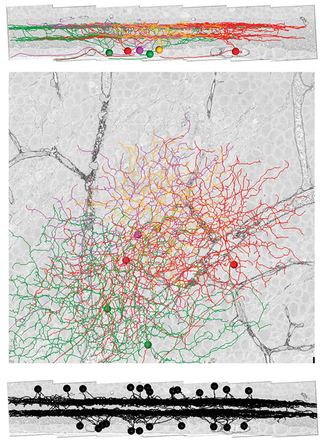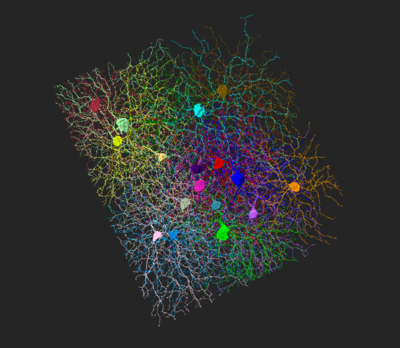Difference between revisions of "On-Off Direction-Selective Ganglion Cell/ko"
(Created page with "Reichardt-Hassenstain 모델을 설명하는 그림 <ref name=\"wiki\" />") |
(Created page with "시각 시스템에 적용되는 이 모델은 인접한 두 세포에 처리된 입력 자극(예, 빛)을 고려합니다. 시간상의 지연이 있은 후, 각각의 지...") |
||
| Line 42: | Line 42: | ||
[[File:Reichardt_model.jpg|thumb|Right|200px|Reichardt-Hassenstain 모델을 설명하는 그림 <ref name=\"wiki\" />]] | [[File:Reichardt_model.jpg|thumb|Right|200px|Reichardt-Hassenstain 모델을 설명하는 그림 <ref name=\"wiki\" />]] | ||
| − | + | 시각 시스템에 적용되는 이 모델은 인접한 두 세포에 처리된 입력 자극(예, 빛)을 고려합니다. 시간상의 지연이 있은 후, 각각의 지연된 입력신호는 다른 세포의 원래 신호에 의해 배가됩니다. 결과적인 신호들은 차감되며 양성 결과는 선호 방향을 나타냅니다<ref name=\"wiki\" />. | |
This behavior was validated in the visual system using calcium imaging in the fly <ref name="hagg2004">J. Haag (2004). Fly Motion Vision Is Based on Reichardt Detectors Regardless of the Signal-to-noise Ratio. Proc. Natl. Acad. Sci. <strong>101</strong> (46): 16333-16338 doi: [http://dx.doi.org/10.1073/pnas.0407368101 10.1073/pnas.0407368101]</ref>. However, this | This behavior was validated in the visual system using calcium imaging in the fly <ref name="hagg2004">J. Haag (2004). Fly Motion Vision Is Based on Reichardt Detectors Regardless of the Signal-to-noise Ratio. Proc. Natl. Acad. Sci. <strong>101</strong> (46): 16333-16338 doi: [http://dx.doi.org/10.1073/pnas.0407368101 10.1073/pnas.0407368101]</ref>. However, this | ||
Revision as of 03:52, 8 January 2016
망막에 있는 방향 선택성 세포들은 시각적 자극의 방향에 다르게 반응하는 신경세포들입니다. 이 단어는 \"자극이 수용장에서 한 방향으로 움직일 때 특히 격렬하게 신호를 발생하는” 한 무리의 신경세포를 묘사하는 데 쓰입니다[1] 생쥐의 망막에선 세 종류의 방향 선택성 세포들이 알려져 있습니다; ON/OFF 방향 선택성 신경절 세포, ON 방향 선택성 신경절 세포(밝은 자극의 이끄는 선두 가장자리에 반응) 및 OFF 방향 선택성 신경절 세포(밝은 자극의 끌리는 꼬리 부분에만 반응)입니다. 각각의 세포는 독특한 생리 및 해부학적 구조를 갖고 있습니다.[2] 이 페이지의 나머지 부분의 내용은 ON/OFF 방향 선택성 신경절 세포에만 해당되는 내용입니다.
Contents
생리(Physiology)

ON/OFF방향 선택성 신경절 세포는 국소적인 움직임 탐지기의 역할을 합니다. 만일 밝은 자극(예를 들어 빛)이 세포가 선호하는 방향으로 움직이면 세포는 이끄는 선두 가장자리와 끌리는 꼬리 쪽 가장자리 모두 에서 신호를 발사합니다. 중요한 대비로써, 밝은 자극이 선호 방향의 반대 방향(반응이 없는 방향)으로 움직이는 경우 매우 적거나 반응이 아예 없게 됩니다.Cite error: Invalid <ref> tag;
refs with no content must have a name 자극에 대한 반응은 크기, 모양, 색깔, 속도 등과 같은 자극의 여러 가지 성질들로부터 독립적입니다. 이들 세포들은 중심-주변 구조를 가지고 있으며 수상돌기의 크기는 중심 수용장의 크기와 관련이 있습니다.Cite error: Invalid <ref> tag;
refs with no content must have a name
ON/OFF 방향 선택성 신경절 세포는 방향 선호의 차이에 따라 4개 군으로 분류할 수 있으며 배, 등, 코, 측두(ventral, dorsal, nasal, temporal)입니다. 다른 군의 세포들은 수지돌기 구조도 다르며 두뇌에서 시냅스의 표적도 다릅니다.Cite error: Invalid <ref> tag;
refs with no content must have a name
1960년대 에 행해진 초기 실험으로부터 수용장은 꽤 넓으며, 작은 변화에 민감하고, 방향 선택적 서브유닛들이 망막을 통해 여러 번 반복적으로 존재한다는 것이 밝혀졌습니다.Cite error: Invalid <ref> tag;
refs with no content must have a name
해부학적 구조(Anatomy)
ON/OFF 방향 선택성 신경절 세포는 보통 내망상층의 두 개 층에 뻗어있는 그들의 복층화된 수지상 가지들에 의해 구별됩니다. 이들 종류의 세포들은 양극성 세포 및 성화상 무축삭 세포들 모두와 시냅스를 형성하는 것으로 알려져 있습니다. 위에서 설명한 바처럼 네 종류의 세포들이 있으며 각각 선호하는 방향을 가지고 있습니다. 각 종류의 ON/OFF 방향 선택성 신경절 세포들은 수상돌기의 형태와 두뇌로의 축삭이 뻗는 데 차이를 보입니다. 이러한 차이는 다른 종류의 세포에서 나오는 출력 신호들은 두뇌의 서로 다른 부분으로 연결될지도 모른다는 것을 나타냅니다.Cite error: Invalid <ref> tag;
refs with no content must have a name
연결(Connections)
흥분 신호는 양극성 세포와 starbusrt 무축삭 세포 모두로부터 오게 됩니다.Cite error: Invalid <ref> tag;
refs with no content must have a name 억제의 주 근원은 성화상 무축삭 세포입니다. 6개의 ON/OFF 방항선택성 신경절 세포의 수동 재구성과 그들의 시냅스 연결 상대들을 이용해 성화상 무축삭 세포와 ON/OFF 방향 선택성 신경절 세포간 시냅스의 90% 이상이 반응이 없는 방향으로 놓여있다는 것이 밝혀졌습니다.Cite error: Invalid <ref> tag;
refs with no content must have a name
첨부된 그림에 나와있는 것처럼, 빛이 광수용체를 통해 망막으로 들어가며 흥분성 입력신호가 양극성 세포와 성화상 무축삭 세포에서 분비된 글루타메이트와 아세틸콜린을 통해 ON/OFF 방항선택성 신경절 세포로 전달됩니다. 반응이 없는 방향에서 정보를 억제(따라서 방향 선택적 움직임 탐지자를 형성)하는 데 중요한 억제성 GABA 입력신호는 성화상 무축삭 세포로부터 받아집니다. 움직임 탐지 결과는 추가적 처리를 위해 두뇌의 상위 부위로 전달됩니다.
4. 분자(Molecules)
위에서 설명한 것처럼, ON/OFF 방향 선택성 신경절 세포는 방향 선호에 따라 배, 등, 코, 측두(ventral, dorsal, nasal, temporal)의 네 종류로 나눌 수 있습니다. 최근 연구에서 이들 다른 종류들을 구분할 수 있는 표지자들이 확인되었으며 ON/OFF 방향 선택성 신경절 세포들을 다른 망막 신경절 세포와 구분할 수 있는 표지자들도 확인되었습니다. 이들 표지자들은 경험과는 독립적이며 어떻게 이들 세포들이 서로 다른 입력 신호를 획득하는지에 대한 방법을 제시해줍니다.
최근의 연구에 의해 배쪽 또는 코쪽 움직임을 선호하는 ON/OFF 방향 선택성 신경절 세포를 선택적으로 표지한 형질변환 유전자 조작 생쥐 및 배쪽과 등쪽을 선호하는 방향 선택성 신경절 세포를 표지하는 형질변환 유전자 조작 생쥐의 개발이 가능하게 했습니다. 이들 동물들은 각각의 서로 다른 4 종류의 ON/OFF 방향 선택성 신경절 세포를 구분할 수 있게 해주는 세포 표면 분자(Cadherin 6, CollagenXXV1 및 Matrix metalloprotease 17 포함)들을 확인하는 데 사용되었습니다. 신경계펩타이드인 CART(cocaine and amphetamine regulated transcript)는 모든 다른 망막 신경절 세포로부터 ON/OFF 방향 선택성 신경절 세포들을 구분하는 데 사용될 수 있습니다. 놀랍게도 이들 분자 분화의 형태는 동물이 눈을 뜨기도 전에 일어나며 이러한 차이들은 경험과는 무관한 것으로 알려졌습니다. 따라서 분자상의 차이는 다른 종류들간의 기능 차이를 설명하는 데 도움이 될 수도 있습니다.[5]
5. 모델
ON/OFF 방향 선택성 신경절 세포의 신호를 발사하는 패턴은 시간 의존적이며 Reichardt- Hassenstain 모델이 지원합니다. 이는 2개의 인접한 세포 사이에서 시공 연관성을 탐지합니다.Cite error: Invalid <ref> tag;
refs with no name must have content
<ref> tag;
refs with no content must have a name시각 시스템에 적용되는 이 모델은 인접한 두 세포에 처리된 입력 자극(예, 빛)을 고려합니다. 시간상의 지연이 있은 후, 각각의 지연된 입력신호는 다른 세포의 원래 신호에 의해 배가됩니다. 결과적인 신호들은 차감되며 양성 결과는 선호 방향을 나타냅니다Cite error: Invalid <ref> tag;
refs with no content must have a name.
This behavior was validated in the visual system using calcium imaging in the fly [6]. However, this model correspondence has only been completed at a high-level (input-output), rather than at an anatomical or physiological level.[7]
History
Direction Selective units were first explored in cats by Hubel and Wiesel in 1959. Levick and Barlow performed many of the seminal early experiments related to direction selectivity during the 1960s using rabbit retina [8]. In these experiments, they measured action potentials generated from a black-white grating with a small slit [9]. Many additional experiments have been performed during the past fifty years in organisms as diverse as the turtle (e.g., Marchiafava 1979) and the mouse (Briggman 2011).
References
- ↑ H. B. Barlow and W. R. Levick (1965) The Mechanism of Directionally Selective Units in Rabbit's Retina J. Physiol. 178: 477-504
- ↑ \"Motion Sensing in Vision.\" Wikipedia, The Free Encyclopedia, http://en.wikipedia.org/wiki/Motion_Sensing_in_Vision (Accessed April 02, 2012).
- ↑ D. I. Vaney, B. Sivyer, and W. R. Taylor (2012). Direction selectivity in the retina: symmetry and asymmetry in structure and function. Nature Neuroscience 13 (3): 194-208
- ↑ A. Borst and T. Euler (2011). Seeing Things in Motion: Models, Circuits, and Mechanisms. Neuron 71 (6): 974-994 doi:10.1016/j.neuron.2011.08.031
- ↑ J. N. Kay et al. (2011) Retinal ganglion cells with distinct directional preferences differ in molecular identity, structure, and central projections. J. Neurosci. 31 (21): 7753-7762 doi: 10.1523/JNEUROSCI.0907-11.2011
- ↑ J. Haag (2004). Fly Motion Vision Is Based on Reichardt Detectors Regardless of the Signal-to-noise Ratio. Proc. Natl. Acad. Sci. 101 (46): 16333-16338 doi: 10.1073/pnas.0407368101
- ↑ Cite error: Invalid
<ref>tag; no text was provided for refs namedborst2011 - ↑ Cite error: Invalid
<ref>tag; no text was provided for refs namedbarlow1965 - ↑ Cite error: Invalid
<ref>tag; no text was provided for refs namedwiki
| ||||||||||||||||||||||||||||||||||||||||||||||||||||||||||||||||||


